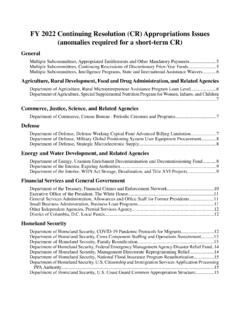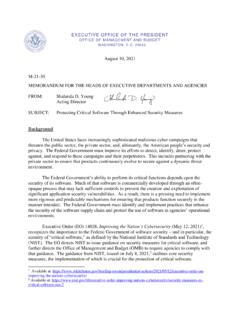Transcription of OFFICE OF MANAGEMENT AND BUDGET WASHINGTON, D.C. …
1 EXECUTIVE OFFICE OF THE PRESIDENT OFFICE OF MANAGEMENT AND BUDGET WASHINGTON, 20503 THE DIRECTOR November 19, 2020 M-21-07 MEMORANDUM FOR HEADS OF EXECUTIVE DEPARTMENTS AND AGENCIES FROM: Russell T. Vought (\ ~ ~ Director \..J '-SUBJECT: Completing the Transition to Internet Protocol Version 6 (1Pv6) This memorandum updates guidance on the Federal government's operational deployment and use of 1Pv6. 1Pv6 is the next-generation Internet protocol, designed to replace version 4 (1Pv4) that has been in use since 1983. Internet Protocol (IP) addresses are the globally unique numeric identifiers necessary to distinguish individual entities that communicate over the Internet. The global demand for IP addresses has grown exponentially with the ever-increasing number of users, devices, and virtual entities connecting to the Internet, resulting in the exhaustion of readily available 1Pv4 addresses in all regions of the world.)
2 Over time, numerous technical and economic stop-gap measures have been developed in an attempt to extend the usable life time of1Pv4, but all of these measures add cost and complexity to network infrastructure and raise significant technical and economic barriers to innovation. It is widely recognized that full transition to 1Pv6 is the only viable option to ensure future growth and innovation in Internet technology and services. 1 It is essential for the Federal government to expand and enhance its strategic commitment to the transition to 1Pv6 in order to keep pace with and capitalize on industry trends. Building on previous initiatives,2 the Federal government remains committed to completing this transition. 3 Beginning in 2005, the Federal government's 1Pv6 initiative served as a vital catalyst, fostering commercial development and adoption of 1Pv6 technology.
3 In the last 5 years, 1Pv6 1 IAB Statement on 1Pv6, The Internet Architecture Board, November 2016, statement-on-ipv6/ . 2 In August 2005, 0MB issued M-05-22, Transition Planning for Internet Protocol Version 6 (1Pv6), requiring agencies to enable 1Pv6 on their backbone networks by June 30, 2008. This policy outlined deployment and acquisition requirements. In September 20 I 0, 0MB issued a memo entitled "Transition to I Pv6," requiring Federal agencies to operationa11y deploy native 1Pv6 for public Internet servers and internal applications that communicate with public servers. Specifically, the 2010 memorandum required agencies to upgrade public/external facing servers and services ( , web, email, DNS, ISP services) to operationa11y use native 1Pv6 by the end of FY 2012; and to and to upgrade internal client applications that communicate with public Internet servers and supporting enterprise networks to operationally use native 1Pv6 by the end of FY 2014.
4 3 This memorandum does not apply to national security systems, although the document may be leveraged to inform their MANAGEMENT processes. momentum in industry has dramatically increased, with large IPv6 commercial deployments in many business seetors now driven by reducing cost, decreasing complexity, improving security and eliminating barriers to innovation in networked information systems. Several large network operators, software vendors, service providers, enterprises, state governments, and foreign governments have deployed significant IPv6 infrastructures. In fact, many of these organizations have migrated, or are planning to migrate, to "IPv6-only"4 infrastructures to reduce operational concerns associated with maintaining two distinct networking regimes. 5 This memorandum communicates the requirements for completing the operational deployment of IPv6 across all Federal information systems and services, and helps agencies overcome barriers that impede them from migrating to IPv6-only network environments.
5 The strategic intent is for the Federal government to deliver its information services, operate its networks, and access the services of others using only IPv6. 6 Specific steps that agencies are expected to take to complete the transition to 1Pv6 Preparing for an 1Pv6-only Infrastructure 0MB previously issued policy discussing the expectation for agencies to run dual stack (IPv4 and IPv6) into the foreseeable future; however, in recent years it has become clear that this approach is overly complex to maintain and unnecessary. As a result, standards bodies and leading technology companies began migrating toward IPv6-only deployments, thereby eliminating complexity, operational cost, and threat vectors associated with operating two network protocols. In many instances where Federal agencies deployed IPv6 on public facing systems, IPv6 access is already being used by as many, or more, users as IPv4.
6 As information technology continues to evolve toward mobile platforms, Internet of Things (IoT), and wireless networks, IPv6 growth will continue to accelerate. The technical, economic and security benefits of operating a single, modern, and scalable network infrastructure are the driving forces for the evolution towards IPv6-only in the private sector. To keep pace with and leverage this evolution in networking technology, agencies shall: 1. Designate an agency-wide IPv6 integrated project team (including acquisition, policy, and technical members), or other governance structure, within 45 days of issuance of this policy to effectively govern and enforce IPv6 efforts; 4 1Pv6-only refers to the state of an operational system or service when 1Pv4 protocol functions (addressing, packet forwarding) are not in use.
7 The NIST USGv6 profile defines technical requirements for a product to be capable of operating in IPv6-only environments. 5 Examples of industry trends in 1Pv6 migration can be found at: https deploy3 60/ipv6/ case-studies/ and https:/ /teamarin. net/ get6/ipv6-case-studies/ . 6 Note that for public Internet services, maintaining viable 1Pv4 interfaces and transition mechanisms at the edge of service infrastructures may be necessary for additional time, but this does not preclude operating the backend infrastructure as IPv6-only. 2 2. Issue and make available on the agency's publicly accessible website, an agency-wide IPv6 policy, within 180 days of issuance of this memorandum. The agency-wide IPv6 policy must require that, no later than Fiscal Year (FY) 2023, all new networked Federal information systems are IPv6-enabled7 at the time of deployment, and state the agency's strategic intent to phase out the use of IPv4 for all systems; 3.
8 Identify opportunities for IPv6 pilots and complete at least one pilot of an IPv6-only operational system by the end of FY 2021 and report the results of the pilot to 0MB upon request;8 4. Develop an IPv6 implementation plan9 by the end of FY 2021, and update the Information Resources MANAGEMENT (IRM) strategic Plan10 as appropriate, to update all networked Federal information systems (and the IP-enabled assets associated with these systems) to fully enable native IPv611 operation. The plan shall describe the agency transition process and include the following milestones and actions: 12 a. At least 20% of IP-enabled assets on Federal networks are operating in IPv6-only environments by the end of FY 2023;13 b. At least 50% of IP-enabled assets on Federal networks are operating in IPv6-only environments by the end of FY 2024; c.
9 At least 80% ofIP-enabled assets on Federal networks are operating in IPv6-only environments by the end of FY 2025; and d. Identify and justify Federal information systems that cannot be converted to use IPv6 and provide a schedule for replacing or retiring these systems; 7 IPv6-enabled refers to a system or service in which the use ofIPv6 is "turned on" for production use. 8 In order to expedite progress towards IPv6-only enterprise deployments, NIST, through the National Cyber Center of Excellence (NCCoE), will establish a cooperative Federal government and industry pilot project to the demonstrate commercial viability and to document a practice guide for secure IPv6-only enterprise deployment scenarios. 9 The IPv6 implementation plan must ensure coordination with other, relevant department modernization initiatives and require that all shared services offered by the agency provide full IPv6 support (including the ability to function in IPv6-only mode) with feature and performance parity with existing IPv4 services.
10 10 Agencies are required to maintain an IRM strategic plan in accordance with 0MB Circular A-130, Managing Iriformation as a strategic Resource. 11 Native IPv6 refers to direct support ofIPv6 in a system or service without requiring the use ofIPv4 for basic communications. 12 0MB guidance has required agencies to acquire and deploy IPv6 capabilities in some systems since 2010. It is recommended that agencies inform the development of their plan with practical experience gained from pilot activities and prior production deployments. Agency plans will evolve over time and thus it is important to identify systems that are already capable of running IPv6 and develop and implement plans to enable IPv6 in those systems first, then evaluate the potential to migrate those systems to IPv6-only environments. 13 Potential starting points might include enabling IPv6 on existing systems that are already capable of running IPv6 ( , focusing on commodity IT systems with commercial off the shelf operating systems that are already capable of running IPv6.)













